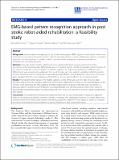EMG-based pattern recognition approach in post stroke robot-aided rehabilitation: a feasibility study
Author(s)
Cesqui, Benedetta; Tropea, Peppino; Micera, Silvestro; Krebs, Hermano Igo
Download1743-0003-10-75.pdf (2.380Mb)
PUBLISHER_CC
Publisher with Creative Commons License
Creative Commons Attribution
Terms of use
Metadata
Show full item recordAbstract
Background:
Several studies investigating the use of electromyographic (EMG) signals in robot-based stroke neuro-rehabilitation to enhance functional recovery. Here we explored whether a classical EMG-based patterns recognition approach could be employed to predict patients’ intentions while attempting to generate goal-directed movements in the horizontal plane.
Methods:
Nine right-handed healthy subjects and seven right-handed stroke survivors performed reaching movements in the horizontal plane. EMG signals were recorded and used to identify the intended motion direction of the subjects. To this aim, a standard pattern recognition algorithm (i.e., Support Vector Machine, SVM) was used. Different tests were carried out to understand the role of the inter- and intra-subjects’ variability in affecting classifier accuracy. Abnormal muscular spatial patterns generating misclassification were evaluated by means of an assessment index calculated from the results achieved with the PCA, i.e., the so-called Coefficient of Expressiveness (CoE).
Results:
Processing the EMG signals of the healthy subjects, in most of the cases we were able to build a static functional map of the EMG activation patterns for point-to-point reaching movements on the horizontal plane. On the contrary, when processing the EMG signals of the pathological subjects a good classification was not possible. In particular, patients’ aimed movement direction was not predictable with sufficient accuracy either when using the general map extracted from data of normal subjects and when tuning the classifier on the EMG signals recorded from each patient.
Conclusions:
The experimental findings herein reported show that the use of EMG patterns recognition approach might not be practical to decode movement intention in subjects with neurological injury such as stroke. Rather than estimate motion from EMGs, future scenarios should encourage the utilization of these signals to detect and interpret the normal and abnormal muscle patterns and provide feedback on their correct recruitment.
Date issued
2013-07Department
Massachusetts Institute of Technology. Department of Mechanical Engineering; Massachusetts Institute of Technology. Newman Laboratory for Biomechanics and Human RehabilitationJournal
Journal of NeuroEngineering and Rehabilitation
Publisher
BioMed Central Ltd
Citation
Cesqui, Benedetta et al. “EMG-based Pattern Recognition Approach in Post Stroke Robot-aided Rehabilitation: a Feasibility Study.” Journal of NeuroEngineering and Rehabilitation 10.1 (2013): 75.
Version: Final published version
ISSN
1743-0003